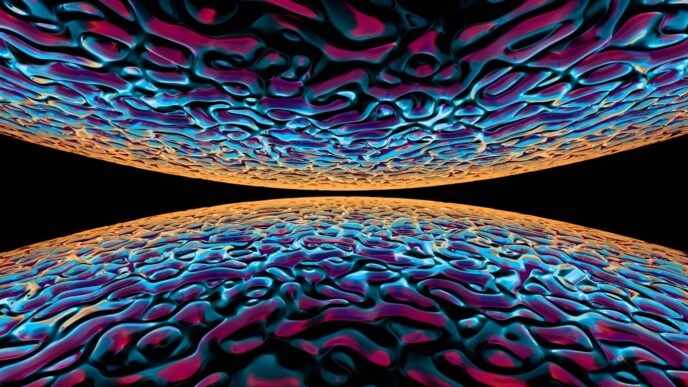Understanding The Fundamentals Of Teleportation

Teleportation. It’s a word that instantly brings to mind spaceships and characters zipping from one planet to another without a second thought. But what exactly is it, and how could it possibly work? Forget the sci-fi magic for a moment; the real science behind teleportation is deeply rooted in some pretty mind-bending physics, specifically quantum mechanics.
What Is Teleportation?
At its core, teleportation is the idea of moving something from point A to point B without it actually traveling through the space in between. Think of it less like a car journey and more like a cosmic fax machine. Instead of physically moving an object, you’re essentially sending the information about that object to a new location and rebuilding it there. The ultimate goal is to transfer an object or person instantaneously from one place to another. This isn’t about just moving matter; it’s about transferring its exact state, its very essence, to a new spot.
The Role Of Quantum Mechanics
This is where things get really interesting, and frankly, a bit weird. Classical physics, the kind that describes how billiard balls move or how planets orbit, just doesn’t cut it for teleportation. We need quantum mechanics, the physics of the super-tiny. Quantum mechanics tells us that particles can exist in multiple states at once (superposition) and that they can be linked in peculiar ways.
Here’s a quick rundown of some key quantum ideas that are relevant:
- Quantum States: This refers to all the properties of a particle, like its spin or polarization. Teleportation is about transferring these states.
- Superposition: A quantum particle can be in many states simultaneously until it’s measured. This makes scanning an object for teleportation tricky.
- Quantum Mechanics: This branch of physics governs the behavior of matter and energy at the atomic and subatomic levels, which is the foundation for understanding teleportation.
Quantum Entanglement’s Crucial Connection
If quantum mechanics is the engine of teleportation, then quantum entanglement is the fuel. Entanglement is this bizarre phenomenon where two or more particles become linked, no matter how far apart they are. If you measure a property of one entangled particle, you instantly know the corresponding property of the other. Einstein famously called it "spooky action at a distance," and it’s absolutely vital for making teleportation work.
Imagine you have two entangled particles, let’s call them Alice and Bob. You send Bob to your destination. Now, if you interact the particle you want to teleport with Alice (which is still with you), the information about that particle gets transferred to Alice. Because Alice and Bob are entangled, Bob instantly takes on the properties of the particle you wanted to teleport. It’s like a cosmic hand-off, happening faster than light could ever travel between the two points.
The Science Behind Instantaneous Travel

So, how do we get from here to there without actually going anywhere? It sounds like magic, but it’s actually rooted in some pretty wild physics. When we talk about teleportation, especially the kind that might one day move us, we’re not talking about beaming ourselves up like on TV. Instead, it’s about breaking something down to its absolute smallest parts and then putting it back together somewhere else.
Disassembling And Transmitting Atomic Information
Imagine you have an object, say, a coffee mug. To teleport it, you’d first need to scan every single atom, figuring out exactly where it is, what it’s doing, and how it’s connected to everything else. This is where things get tricky. The act of measuring something at this tiny level actually changes it. It’s like trying to get a perfect picture of a water droplet – the moment you try to focus, you disturb it. So, you can’t just measure it and then have the original still there. The original object, in its exact state, has to be destroyed in the process of scanning. This information, this incredibly detailed blueprint, then needs to be sent to the destination.
Reassembling Matter At A New Location
Once the atomic blueprint arrives at the destination, the real construction begins. Using raw materials already present at the receiving end, a new object is built, atom by atom, following the exact specifications from the transmitted data. It’s like having a super-advanced 3D printer that can assemble matter itself. The goal is to create a perfect replica, indistinguishable from the original. This process relies heavily on quantum mechanics, particularly the idea of quantum states, which describe the properties of particles.
The No-Cloning Theorem’s Implications
Here’s a big hurdle: the no-cloning theorem. This is a rule in quantum mechanics that basically says you can’t make an exact copy of an unknown quantum state. You can’t just measure something, copy its state, and then have both the original and the copy. Because the scanning process itself alters the original, you’re not really copying; you’re transferring the state. The original is gone, and a new one is created. This is why teleportation, as we understand it now, involves destruction at the source and recreation at the destination, not duplication.
Quantum Teleportation: A Scientific Reality
Okay, so when we talk about teleportation in the real world, we’re not talking about beaming Captain Kirk across the galaxy. That’s still firmly in the sci-fi bin. What scientists have managed to do, though, is pretty mind-blowing in its own right. It’s called quantum teleportation, and it’s all about moving information, not matter.
Transferring Quantum States Without Physical Movement
Think of it like this: instead of sending a physical package, you’re sending the instructions on how to build that exact package somewhere else. In quantum teleportation, we’re transferring the exact state of a quantum particle – like its spin or polarization – from one place to another. The particle itself doesn’t go anywhere. It’s like sending a blueprint, not the building.
- The original particle’s state is destroyed at the source. This is a big deal and is tied to a rule called the no-cloning theorem. You can’t just copy a quantum state perfectly.
- We use a special quantum trick called entanglement. Imagine two coins that are linked. If one lands heads, you instantly know the other is tails, no matter how far apart they are. Entangled particles work similarly, but with their quantum properties.
- This process allows us to send the information about a quantum state across distances without physically moving the particle that held that information.
How Information Travels Across Space
So, how does this information actually get from point A to point B without a physical carrier? It’s not quite as simple as just flipping a switch. It involves a few steps and relies heavily on that entanglement we just talked about.
- Entanglement Setup: You need a pair of entangled particles. Let’s call them Particle B and Particle C. Particle B stays with the sender, and Particle C is sent to the receiver.
- Interaction and Measurement: The sender then interacts the particle they want to
Milestones In Teleportation Experiments
So, we’ve talked about what teleportation is and the wild science behind it. Now, let’s look at where we actually are with this stuff. It’s not quite Star Trek yet, but scientists have been doing some pretty neat things in labs.
Early Photon Teleportation Achievements
Back in 1997, a group in Austria, led by Anton Zeilinger, managed to do something pretty groundbreaking. They successfully teleported a quantum state from one photon to another. How? They basically linked up two photons using something called entanglement. Then, by checking out one of the photons, they could figure out the state of the other one, even though they weren’t physically connected in the usual way. This was a huge step because it showed that this quantum information transfer was actually possible.
Advancements In Atom And Ion Teleportation
Things didn’t stop with photons. A few years later, around 2004, researchers at NIST and the University of Innsbruck took it a step further. They managed to teleport the quantum states of individual atoms. They used two beryllium ions, got them entangled, and then moved their quantum information from one to the other. It was over a short distance, sure, but it proved we could do this with more than just light particles.
Long-Distance Quantum Information Transfer
Then, the distances started to grow. By 2012, scientists in Tokyo were sending quantum information across the city, a few kilometers, using optical fibers and entanglement. And NIST researchers kept pushing the envelope. In 2015, they managed to send quantum information over 100 kilometers of optical fiber. That was a massive jump from what had been done before. It really showed that sending this quantum data over long hauls was becoming a real possibility, which is super important for things like a future quantum internet.
Challenges In Teleporting Complex Organisms
So, teleporting a single atom or even a small group of them? That’s one thing. But zapping a whole human being from, say, New York to Tokyo? That’s a whole different ballgame, and honestly, it’s a pretty massive hurdle right now.
The Immense Complexity Of Human Body Teleportation
Think about it. A human body isn’t just a few atoms; it’s trillions upon trillions of them, all arranged in incredibly specific ways. We’re talking about every single cell, every molecule, every protein, all needing to be scanned, recorded, and then perfectly rebuilt. It’s like trying to copy a library, not just the books, but the exact placement of every single letter on every page, and then rebuilding that library somewhere else. The sheer amount of data involved is almost impossible to wrap our heads around. Current technology can’t even begin to handle that kind of information.
Data Processing And Transmission Hurdles
Even if we could somehow scan a person down to the atomic level, the next problem is what to do with all that information. We’d need computers that are orders of magnitude more powerful than anything we have today, just to process the data. Then, we’d have to send it. Imagine trying to transmit that colossal amount of data across the globe instantaneously. It’s not just about speed; it’s about the capacity to send that much information without any errors. A single misplaced atom could have, well, let’s just say ‘unpleasant’ consequences.
Preserving Consciousness And Identity
This is where things get really philosophical, and frankly, a bit spooky. If you’re disassembled atom by atom, and then reassembled somewhere else, are you still you? What happens to your thoughts, your memories, your sense of self? Does consciousness just get copied, or is it something more? We don’t have answers to these questions, and until we do, teleporting a living, thinking being is not just a technical problem, but a profound existential one. It’s a bit like asking if a fax machine truly sends the original document or just a copy, but on a scale that affects our very being.
Potential Applications Of Teleportation
While the idea of beaming ourselves across the galaxy like in the movies is still a ways off, the science behind teleportation, particularly quantum teleportation, is already opening doors to some pretty amazing possibilities. It’s not just about zapping people from point A to point B; it’s about how we handle and move information.
Revolutionizing Travel and Commuting
Okay, so maybe not for us humans just yet, but imagine a world where physical goods don’t need to be shipped. Think about critical medical supplies, like organs for transplant, being instantly sent to where they’re needed most. Or perhaps components for manufacturing could be teleported directly to assembly lines, cutting down on massive logistical chains. This could drastically reduce the environmental impact of transportation and speed up delivery times to an unimaginable degree.
Enabling Secure Quantum Communication
This is where quantum teleportation is already making waves. It’s a key ingredient for building a future "Quantum Internet." Instead of sending data through traditional cables, which can be intercepted, quantum communication uses the principles of entanglement to transmit information in a way that’s inherently secure. If anyone tries to eavesdrop, the very act of observation would break the entanglement, alerting the sender and receiver. This could lead to:
- Unbreakable Encryption: Protecting sensitive government and financial data.
- Secure Voting Systems: Ensuring election integrity.
- Private Communication Networks: For individuals and organizations.
Advancing Quantum Computing Capabilities
Quantum computers are incredibly powerful, but they’re also quite fragile and difficult to scale. Quantum teleportation offers a way to link different quantum processors together, effectively creating a larger, more robust quantum computing network. This could allow us to:
- Share Quantum Resources: Distributing the power of a large quantum computer to multiple users.
- Build Distributed Quantum Computers: Combining smaller quantum machines to tackle bigger problems.
- Improve Error Correction: Teleporting quantum information to error-correction modules.
Ethical Considerations And Future Prospects
So, we’ve talked a lot about the science, the amazing breakthroughs, and what teleportation could do. But before we start packing our bags for a trip to Mars via instant transport, we really need to think about the bigger picture. It’s not just about the ‘how,’ but the ‘should we?’ and ‘what happens next?’
Questions Of Personal Identity And Selfhood
This is where things get really mind-bending. If you’re disassembled atom by atom and then reassembled somewhere else, are you still you? It’s like making a perfect copy of a document, but then shredding the original. Does the copy have the same essence? Philosophers have been wrestling with this for ages, and teleportation just throws a giant wrench into the works. We’re talking about the continuity of consciousness – that feeling of being ‘me’ from one moment to the next. Does the process preserve that, or does it create a new ‘you’ while the old one ceases to exist? It’s a question that science alone can’t answer, and it’s something we’d have to grapple with as a society.
Risks Of Data Corruption
Imagine this: you’re being teleported, and somewhere in the vast stream of data being sent from point A to point B, a tiny bit gets scrambled. Maybe a single bit flips. What does that mean for the person being reassembled? It could be something minor, like a slightly different hair color. Or, it could be something far more serious, leading to significant physical or even mental changes. The sheer amount of information needed to describe a human being is astronomical. Keeping that data perfectly intact during transmission is a monumental task. We’re talking about error rates that need to be practically zero. Even a minuscule error could have catastrophic consequences.
The Long Road To Realizing Teleportation
Let’s be real, we’re not booking our teleportation tickets anytime soon. The hurdles are immense. We’ve seen success with tiny particles like photons and even some atoms, but scaling that up to something as complex as a human is a whole different ballgame. Think about the sheer number of particles involved – it’s mind-boggling. Then there’s the energy required, the computational power to process all that data, and the infrastructure needed. It’s not just a technological challenge; it’s an economic and logistical one too.
Here’s a rough idea of the scale of the problem:
| Component | Estimated Complexity |
|---|---|
| Number of atoms in a human body | ~7 x 10^27 |
| Data storage required (bits per atom) | Potentially thousands |
| Transmission speed needed | Unimaginable |
So, while the dream of teleportation is exciting, and the scientific progress is fascinating, we’ve got a long, long way to go. It’s a journey that will require not just scientific ingenuity but also careful ethical consideration and a whole lot of societal discussion.
So, What’s the Takeaway?
Alright, so we’ve talked a lot about teleportation, right? It’s super cool to think about zipping from one place to another instantly, like in the movies. And guess what? Scientists are actually making progress, mostly with tiny things like light particles. They’re using this weird quantum entanglement thing to send information, not actual stuff, across distances. But beaming a whole person? That’s a whole different ballgame. It’s incredibly complicated, and we’re a long, long way from that. Plus, there are some big questions about what it would even mean for us. For now, it looks like we’ll be sticking to planes, trains, and automobiles for a while. Still, it’s pretty amazing what science is figuring out, even if it’s not quite Star Trek levels yet.














